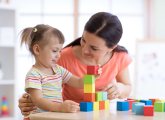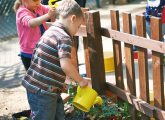With a bit of imagination and some well-chosen objects, you can use loose parts play to unleash children’s inner creativity, says James Tunnell from Nursery Nook…
To many, pine cones are just a nice thing you see on autumnal nature walks. But to an EYFS practitioner looking to nurture the creative development of their charges, these pine cones become what we call ‘loose parts’. And they can hold endless possibilities…
As noted academic Simon Nicholson discussed in his paper, How Not to Cheat Children, ‘loose variables’ are objects, sometimes found in nature or classified as spare parts or junk, that children can access and use in their imaginative play.
These objects can take children on what learning expert Resnick calls a ‘creativity spiral’. Children bring an idea to the setting with them and use the available materials to create something.
Once built, they move to adapting – rebuilding or improving upon their creation. Finally, they share their work and reflecting on the process.
It’s a spiral because children can re-engage with the process again and again, depending on the kind of feedback they receive and their level of interest.
Unfortunately, not all children pass through this process so easily. Some children avoid using these resources whereas others may use them in a way you didn’t intend.
Through my work with settings, I’ve found that there are usually two common reasons for this. You can work through them with a few tweaks.
The first challenge may be that some children are not used to playing with the resources provided by their setting. Many practitioners provide natural resources for loose parts play, but some children may prefer moulded toys, or to repurpose bottle tops and plastic bottles in their play.
This can be referred to as their ‘play diet’, and children may prefer to continue this play in the setting. In these instances, we can help children to step into the loose parts play realm by using familiar variables. This might be things such as straws and bottle tops, alongside the items in their usual ‘play diet’.
The second challenge can be around the experiences a child may or may not be able to bring to their loose parts play. This depends on how limited their real world interaction has been so far.
Arts education specialist Ken Robinson says that “imagination is to bring into mind something which is not present in our senses.’
We know that children play with what they know, and so it is unlikely that a child with no experience of an airport will suddenly create one.
This is where our cultural capital comes in. As part of our curricula, we should plan plenty of developmentally appropriate experiences which we know are new to our cohorts.
However, even when working with a more limited frame of reference, we can still see that all children have some experiences to draw on, even if they are not as grand as we would hope.
For example, a child who watches Peppa Pig on YouTube may create Peppa’s house using materials from the provision.
Our role varies depending on the skills of the child. For those children with more experiences, we can facilitate deeper learning by asking deeper questions.
You might question a child who has created a zoo about where guests buy their tickets or have their lunch. This might spark a memory in the child who can then adapt their creation accordingly.
For those who do not naturally gravitate towards this type of play, our role becomes much more about modelling. Rather than seeing our children pass through the creativity spiral, we as adults must pass through it and model it to the children.
You could sit in the construction area and begin to build Elsa’s ice castle. As you build you can speak aloud, adding a narrative which supports the children in understanding your thought processes and actions.
You can model making a mistake and ask the children if they could help to fix the castle. Over time children will begin to lead on this type of play themselves as their experiences and confidence grows.
Loose parts play will look different in each setting, as you have a unique group of children. It’s very important not to rush into swapping all your resources with open-ended ones.
Children must be able to play with what they know. Begin by spending some time thinking about the balance of resources you have in your setting. Do you have resources that reflect the play diet of your children?
Know your children and the kind of play they gravitate towards. Establish your loose parts play continuous provision based on this.
For example, if you have children who are very active and prefer to build outdoors, ensure you have lots of large moveable equipment. This might include bread and milk crates, guttering and netting.
Work alongside your children and observe if they can engage in the creativity spiral alone. If they’re struggling you can model this yourself.
If they’re still struggling, you may need to step back even further and explore the resources together. Model using your senses to better understand the resources. Then demonstrate simple ways of using them, for example, rolling a pine cone.
Don’t steer the play with disconnected questions. If a child is building a castle don’t ask, “How many blocks did you use?”.
It’s not adding to the experience for the child. If you’re struggling to think of something to say simply watch and wait to be invited in.
Loose parts play is only one small part of your everyday provision, and not everyone will want to engage in it. But with some guidance and encouragement, you may be surprised with the wildly imaginative creations your children come up with!
James Tunnell runs Nursery Nook Training and Consultancy.

Language rich environment – How to create one in EYFS
Editors picks

Montessori outdoor play – Connecting kids with nature
Editors picks
